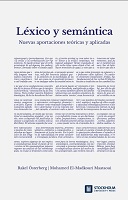Léxico y semántica
nuevas aportaciones teóricas y aplicadas
Contributor(s)
Österberg, Rakel (editor)
El-Madkouri Maataoui, Mohamed (editor)
Language
SpanishAbstract
In fact, from an etymological perspective, contributions have been presented on prepositional parasynthesis and preverbiation, as well as verbal parasynthetic formations.
The diachronic aspect of semantics, marginalized until the very end of the 1960s, is the vision with which lexical change, etymological series and the tension between innovation and tradition in lexical-semantic changes have been focused.
From this same diachronic perspective, together with linguistic theories of reception, the reception of lexical pieces and semantic change, as well as etymological opacity and significant slippage, have been studied. These etymological shifts, semantic slips and deviations can only be productively studied diachronically for the lexicon, and diachronically and pragmatically for the lexicon in use.
The study of the lexicon, from this approach, meets two fundamental requirements in linguistic descriptions: the general historical and diachronic dimension and the current synchronic dimension; the lexical systemic (dictionary) and the usual social (language in use). This is how it can be understood that we can find in this work not only the Latin and Spanish lexicon, but a glossary from 1600, as well as examples from Japanese and Arabic. Likewise, there are also conceptual and terminological descriptions referring to the lexicon and language contact in specialty languages, especially English and French. In these terminological analyzes very marked defining characteristics can be seen, particularly in relation to the techno-scientific record and legal language.
Onomatopoeia, semantically conditioned semi-lexical elements, have been studied from the point of view of contrastive linguistics, not focusing exclusively on the intralinguistic aspect, but also the extralinguistic aspect.
The semantic distribution of the peripheral constituents of the left and the right is also one of the great contributions of this book where the corpus of analysis is a compilation of linguistic productions of very advanced users of L2 Spanish.
The change of meaning in translation and the problems generated by the translation of religious phraseologisms in the framework of judicial interpretation have also been studied, with implications that go beyond the conventional dictionary meaning to influence the ideological conditioning of the meaning.
The lexicon of emotions and phraseological discourse is also present in this work, addressing the topic from a cognitive perspective.
There is, of course, no shortage of the informatics and computational perspective of natural language processing, specifically when it involves machine translation, and lately machine interpretation. In fact, one of the approaches to semantic analyzes is the exploration of the translatability of specific cases of natural language by some machine translation programs.
Keywords
Automated translations of phraseologisms; Enfermedad de Alzheimer; Discurso oral; Left- and right- periphery; Onomatopoeia; Specialized languages; Romancero nuevo; TranslationDOI
10.16993/bclISBN
9789176352397, 9789176352410, 9789176352427, 9789176352403Publisher
Stockholm University PressPublisher website
https://www.stockholmuniversitypress.se/Publication date and place
2024Grantor
Series
Stockholm Studies in Romance Languages, 9Classification
Computational and corpus linguistics
Linguistics
Language acquisition
Semantics, discourse analysis, stylistics


 Download
Download Web Shop
Web Shop